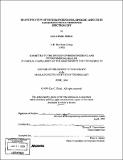| dc.contributor.advisor | Steven R. Tannenbaum. | en_US |
| dc.contributor.author | Özbal, Can Cemil, 1971- | en_US |
| dc.contributor.other | Massachusetts Institute of Technology. Division of Bioengineering and Environmental Health. | en_US |
| dc.date.accessioned | 2007-08-03T15:35:25Z | |
| dc.date.available | 2007-08-03T15:35:25Z | |
| dc.date.copyright | 1999 | en_US |
| dc.date.issued | 1999 | en_US |
| dc.identifier.uri | http://dspace.mit.edu/handle/1721.1/9513 | en_US |
| dc.identifier.uri | http://hdl.handle.net/1721.1/9513 | |
| dc.description | Thesis (Ph.D.)--Massachusetts Institute of Technology, Division of Bioengineering and Environmental Health, 1999. | en_US |
| dc.description | Includes bibliographical references. | en_US |
| dc.description.abstract | Quantification of adducts in human samples is a challenging task in analytical chemistry. Humans are typically exposed to low levels of a wide range of different carcinogens. As a result, adduct quantification requires both a highly sensitive and a highly selective method. This project has focused on the development of new laser-induced fluorescence (LIF) based methods for the quantification of adducts in human samples. Two new instruments were built for LIF analysis. A cryogenic LIF instrument using a pulsed tunable dye laser as the excitation source was developed to obtain low temperature fluorescence emission spectra. A second instrument using a LIF detector interfaced to a HPLC separation system was developed to provide a higher level of selectivity than the cryogenic LIF system. The LIF instruments were used to quantify adducts of benzo[a]pyrene-7,8-diol-9,10- epoxide (BPDE) in human lung tissue and human bronchial epithelial cell histones and DNA and in human serum albumin. The presence of BPDE adducts in human lung tissue and human bronchial epithelial cell histones and DNA was proven by cryogenic fluorescence line-narrowing (FLN) spectroscopy. (-)-anti-BPDE-serum albumin adducts were quantified by HPLC-LIF in plasma obtained from 63 healthy volunteers. The method was shown to have a coefficient of variability of 22% and a detection limit of 20 attomoles of BPDE adduct. Adducts were detected in 60 of 63 samples (95%) at an average level of 0.22 femtomoles of adduct per mg of albumin. The investigation of histones as possible long-term molecular dosimeters was another focus in this research. The close proximity of histones and DNA coupled with the lack of repair and long lifetime make histones very attractive candidates as molecular dosimeters. The kinetics of histone turnover can most likely be accurately modeled by cellular turnover rates in vivo. Histone adducts were detected in human lung tissue and human bronchial epithelial cells. Histones were also shown to form adducts with BPDE, aflatoxin B1 (AFB,) and nitrosomethylurea (NMU) in TK6 cells grown in vitro. Histone adducts of AFB 1 , NMU, and BPDE were shown to be stable over 5 cell divisions. | en_US |
| dc.description.statementofresponsibility | by Can Cemil Özbal. | en_US |
| dc.format.extent | 188 leaves | en_US |
| dc.language.iso | eng | en_US |
| dc.publisher | Massachusetts Institute of Technology | en_US |
| dc.rights | MIT theses are protected by copyright. They may be viewed, downloaded, or printed from this source but further reproduction or distribution in any format is prohibited without written permission. | en_US |
| dc.rights.uri | http://dspace.mit.edu/handle/1721.1/9513 | en_US |
| dc.rights.uri | http://dspace.mit.edu/handle/1721.1/7582 | |
| dc.subject | Division of Bioengineering and Environmental Health. | en_US |
| dc.title | Quantification of benzo[a]pyrene-diol-epoxide adducts by laser-induced fluorescence spectroscopy | en_US |
| dc.type | Thesis | en_US |
| dc.description.degree | Ph.D. | en_US |
| dc.contributor.department | Massachusetts Institute of Technology. Division of Bioengineering and Environmental Health | en_US |
| dc.contributor.department | Massachusetts Institute of Technology. Department of Biological Engineering | |
| dc.identifier.oclc | 43782860 | en_US |

